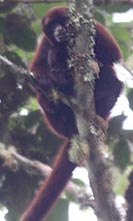Get
To Know
|
 The
Yellow-tailed Woolly Monkey is a rare primate found only in
the Peruvian Andes where they live in rough terrain in the cloud
forest. They are arboreal and diurnal and adult males can reach
sizes of 51.3 to 53.5 cm with tails even longer than the body and
can weigh as much as 11 kg. Their fur is longer and denser than
other woolly monkeys which is an adaptation to its cold mountain
habitat. They are deep mahogany and copper with a whitish patch
on their snout extending from the chin between their eyes. Their
fur gets darker towards their upper body, making their head seem
almost black. Their powerful prehensile tail is capable of supporting
their entire body weight and it also uses its tail to help move
through the canopy. They have been known to leap 15 metres. They
live in large mixed social groups of approximately 23 individuals
and they have a multiple-male group social system and a polygamous
mating system. For all that, they have low reproductive rates and
long inter-birth intervals, which adds to their vulnerability for
extinction. They express aggressive behaviors upon initial encounters
such as branch shaking, showing their buttocks, and making short
barking calls. Their diet is primarily frugivorous, but they also
eat leaves, flowers, insects and other invertebrates. Oddly, they
also engage in geophagy, or the consumption of soil. Geophagy is
a rare biological behavior but the species benefits from this tendency
since it allows for the intake of minerals and the detoxification
of the intestinal region of parasites and other diseases. Perhaps
related to the fact that they tend to suffer from an iron deficient
diet, their consumption of soil allows iron that they do not get
from their regular diet. Although, like most primates, the Yellow-Tailed
monkey has low birth rates, their main threats are all human-related.
The last estimated population count was less than 250 individuals,
largely because of the loss of habitat due to slash and burn agriculture.
Afraid of losing their farmland to conservation efforts of the species,
a rising population of farmers say they do not hunt the monkeys
but that the land is necessary for growing coffee and raising cattle.
The construction of new roads, habitat loss and fragmentation from
agriculture, logging and cattle ranching, and subsistence hunting,
together with the monkey's naturally low population densities, slow
maturation, low reproductive rate, have led to a predicted decline
of at least 80% over the next three generations. They are considered
one of the world's 25 most endangered primates. The
Yellow-tailed Woolly Monkey is a rare primate found only in
the Peruvian Andes where they live in rough terrain in the cloud
forest. They are arboreal and diurnal and adult males can reach
sizes of 51.3 to 53.5 cm with tails even longer than the body and
can weigh as much as 11 kg. Their fur is longer and denser than
other woolly monkeys which is an adaptation to its cold mountain
habitat. They are deep mahogany and copper with a whitish patch
on their snout extending from the chin between their eyes. Their
fur gets darker towards their upper body, making their head seem
almost black. Their powerful prehensile tail is capable of supporting
their entire body weight and it also uses its tail to help move
through the canopy. They have been known to leap 15 metres. They
live in large mixed social groups of approximately 23 individuals
and they have a multiple-male group social system and a polygamous
mating system. For all that, they have low reproductive rates and
long inter-birth intervals, which adds to their vulnerability for
extinction. They express aggressive behaviors upon initial encounters
such as branch shaking, showing their buttocks, and making short
barking calls. Their diet is primarily frugivorous, but they also
eat leaves, flowers, insects and other invertebrates. Oddly, they
also engage in geophagy, or the consumption of soil. Geophagy is
a rare biological behavior but the species benefits from this tendency
since it allows for the intake of minerals and the detoxification
of the intestinal region of parasites and other diseases. Perhaps
related to the fact that they tend to suffer from an iron deficient
diet, their consumption of soil allows iron that they do not get
from their regular diet. Although, like most primates, the Yellow-Tailed
monkey has low birth rates, their main threats are all human-related.
The last estimated population count was less than 250 individuals,
largely because of the loss of habitat due to slash and burn agriculture.
Afraid of losing their farmland to conservation efforts of the species,
a rising population of farmers say they do not hunt the monkeys
but that the land is necessary for growing coffee and raising cattle.
The construction of new roads, habitat loss and fragmentation from
agriculture, logging and cattle ranching, and subsistence hunting,
together with the monkey's naturally low population densities, slow
maturation, low reproductive rate, have led to a predicted decline
of at least 80% over the next three generations. They are considered
one of the world's 25 most endangered primates.
|
|
|
|
we didn't want to see the body
the smell was coming from her apartment
and our mother had shot herself.
I said I wanted proof she was dead
I asked, "Are you sure you burned the right body?"
the urn was so small. copper, tastefully etched
later, my brother and I got so drunk
we got into a fight, took it out to the street
I tried to hit him and missed.
Holly Day has taught writing classes at the Loft Literary Center in Minnesota,
since 2000. Her poetry has recently appeared in Oyez Review, SLAB,
and Gargoyle, while her recently published books include Music
Theory for Dummies (3rd edition), Piano All-in-One for Dummies,
The Book Of, and Nordeast Minneapolis: A History.
|
 The
Yellow-tailed Woolly Monkey - Issue Twenty-Four
The
Yellow-tailed Woolly Monkey - Issue Twenty-Four